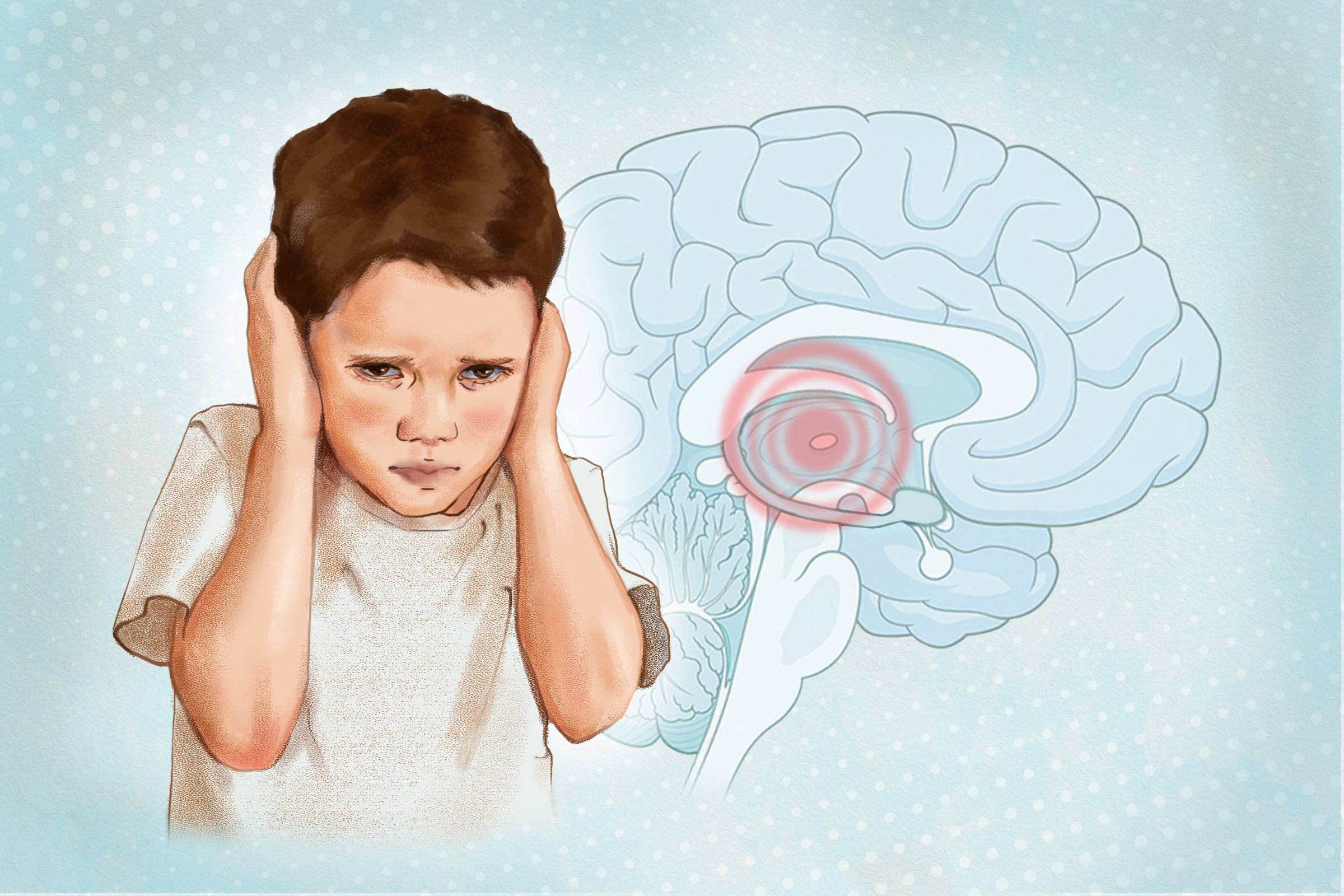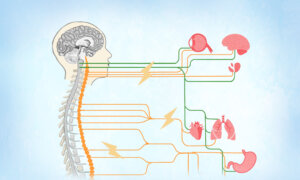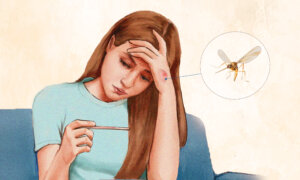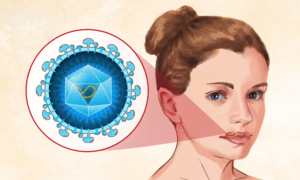Autism spectrum disorder (ASD), or just autism, is a neurological and developmental condition that affects social interaction, communication, learning, and behavior. It encompasses a range of conditions related to brain development.
Globally, around 1 percent of children have autism. In the United States, however, one in 36 children and one in 45 adults have autism, with the condition affecting around 4 percent of boys and 1 percent of girls. The prevalence is up from one in 44 in 2020 and has almost tripled since 2000 when it was one in 150.

While ASD has no clear single cause, a combination of genetics, environmental, and brain-structure factors are believed to be involved. (Illustration by The Epoch Times, Shutterstock)
“On the spectrum” refers to individuals who share core characteristics of autism while recognizing that each person’s autistic experience is unique, complex, and can change over time.
Thinking about autism as on a linear spectrum can be misleading, as it suggests a person can have “more” or “less” autism, leading to oversimplified labels such as “higher” or “lower functioning.” Instead, autism is better understood as a range of diverse traits, strengths, and challenges that vary for each individual.
Early Signs
The first signs of autism typically appear in early childhood and can be detected through screening in children as young as 12 months old or as old as 24 months. However, the condition may be missed until much later.
Early signs of ASD by age include the following:
- 6 to 12 months: Limited smiling, eye contact, or reciprocal social interactions; diminished babbling or gestures; and reduced response to name
- 9 to 12 months: Repetitive behaviors (e.g., spinning and lining up objects) and unusual play (intense focus on toys’ visual or tactile features)
- 12 to 18 months: Lack of single words, compensatory gestures (e.g., pointing), and pretend play; and limited joint attention (initiating and sharing interests)
- 15 to 24 months: Little to no spontaneous two-word phrases
Signs and Symptoms
The following are common behaviors observed in individuals with ASD. While not all autistic individuals exhibit every behavior, most will show several traits. Some of these behaviors can also occur in people without ASD.
Social interactions:
- Minimal or inconsistent eye contact with others
- Appearing disinterested or inattentive when others are speaking
- Rarely sharing enthusiasm or feelings about objects or activities
- Avoiding physical affection and preferring solitary play, often withdrawing into their own world
- Not responding or taking a long time to respond when called by name
- Limited or delayed speech or loss of previously acquired words
- Struggling with the give-and-take aspect of conversations
- Echoing words or phrases without grasping their meaning
- Having trouble comprehending basic questions or instructions
- Relying on memorized scripted speech instead of using spontaneous language
- Using pronouns incorrectly, such as saying “you” instead of “I” or “me” when referring to themselves
- Talking extensively about specific topics without recognizing others’ disinterest or allowing them to contribute
- Using facial expressions and gestures that are inconsistent with their verbal messages
- Exhibiting an unusual voice quality, such as a sing-song or monotone
- Struggling to grasp others’ perspectives or anticipate their behavior
- Showing little emotional expression and appearing unaware of others’ emotions or exhibiting abnormal expressions of empathy
- Struggling to understand nonverbal cues such as body language or tone of voice
- Not developing close personal relationships, especially outside the family
- Lack of speech, in severe cases
- Taking things very literally, such as not understanding sarcasm or expressions such as “it’s raining cats and dogs”
Restrictive or repetitive behaviors:
- Stimming (self-stimulating behaviors), which involves repetitive body movements or the manipulation of objects. While common among autistic individuals, it is a behavior that nearly everyone exhibits in some form, such as nail biting. For autistic people, stimming can occasionally interfere with daily life or cause harm but often serves as a coping mechanism for managing sensory overload or stressful situations.
- Establishing rigid routines or rituals and becoming upset with even minor changes.
- Experiencing coordination issues or displaying unusual movement patterns, such as clumsiness, toe-walking, or exaggerated body language.
- Displaying severe tantrums or emotional outbursts.
- Fixating on a single topic or activity or maintaining a deep, enduring interest in particular subjects such as numbers or facts.
- Showing limited attention span.
- Picky eating, such as preferring only a few foods or avoiding certain textures.
- Showing heightened or diminished sensitivity to sensory stimuli such as light, sound, clothing, or temperature.
- Developing an intense attachment to specific inanimate objects.
- Having highly specialized and sometimes unusual interests (e.g., intense fascination with vacuum cleaners).
People on the autism spectrum often have notable strengths, such as the ability to learn and retain detailed information, strong visual and auditory learning skills, and excellence in memory, math, science, music, or art. They may also notice subtle details, patterns, smells, or sounds that others may overlook.
Autism Signs in Females
Autism symptoms in women and girls may be different from those in males. According to the DSM-5-TR, autistic females may exhibit:
- Enhanced reciprocal conversation skills
- Improved understanding of verbal and nonverbal communication
- Greater ability to adapt their behavior to different situations
- Less noticeable repetitive behaviors
- More socially accepted special interests (e.g., celebrities)
Research indicates that females are more likely to mask their autism symptoms to fit in than males. They may stay close to
peers and move in and out of activities, regardless of engagement status.
Research indicates autism arises from a combination of genetic and environmental factors, as well as abnormal brain development.
Genetics
Genetic factors are believed to contribute 40 percent to 80 percent of autism risk. Over 1,000 genes have been linked to ASD, although many associations remain unconfirmed. Common gene variations may increase ASD risk, but most have a small individual effect, and not everyone with these variations develops ASD.
In about 2 percent to 4 percent of cases, rare gene mutations or chromosomal abnormalities are a direct cause, as with ADNP syndrome, also known as Helsmoortel-Van der Aa syndrome (HVDAS). Some other genes whose rare mutations are associated with autism include ARID1B, ASH1L, CHD2, CHD8, DYRK1A, POGZ, SHANK3, and SYNGAP1. Many ASD-associated genes play roles in brain development or regulate other genes or proteins.
In some children, autism may be linked to a genetic condition such as fragile X syndrome or Down syndrome.
Brain Development
Research suggests that during brain development, individuals with ASD may have an excess of neurons and overgrowth in parts of the brain’s outer layer, the cortex. Additionally, there are irregular areas where the typical structure of the cortex is disrupted. The cortex normally has six layers, formed before birth, each with specialized neurons and connections. These abnormalities are seen in the frontal and temporal lobes, regions involved in emotions, social behavior, and language. These differences are believed to contribute to the social, communication, and cognitive challenges associated with autism.
Other parts of the autistic brain that exhibit abnormalities include the cerebellum and the amygdala. However, it is unclear whether these brain changes spur autism or vice versa.
Environmental Factors
Environmental factors can range from infections and diseases to toxins and maternal health during pregnancy. They include:
- Certain diseases: An ASD subtype called childhood disintegrative disorder is associated with certain diseases, especially if it is late-onset, including subacute sclerosing panencephalitis (a chronic brain infection caused by a measles virus form), tuberous sclerosis (a genetic disorder characterized by benign tumor formation in the brain and other organs), leukodystrophy (a condition involving maldevelopment of the myelin sheath, leading to the disintegration of white matter in the brain), and lipid storage diseases (disorders where excessive fat accumulates in the brain and nervous system, causing toxicity).
- Prenatal infections: Examples include rubella and cytomegalovirus infections.
- Maternal immune conditions: Maternal immune conditions increase autism risk in children. A 2020 study found that maternal asthma was the most frequently reported in mothers of children with ASD. Autistic boys were more likely to have mothers with a history of immune conditions than girls with ASD.
- Prenatal exposure to air pollution: Exposure to PM2.5 (particulate matter that is 2.5 micrometers or smaller in diameter) during the first two trimesters of pregnancy was linked to a higher risk of ASD in children, especially boys.
- Exposure to toxins in the womb: Being exposed to toxins (e.g., heavy metals) or medications (e.g., antidepressants, valproic acid, and thalidomide) while in the womb or in early childhood could raise the risk of autism.
- Lower levels of manganese and zinc.
- Maternal diabetes and obesity: Maternal preexisting Type 2 diabetes, Type 1 diabetes, and gestational diabetes diagnosed by 26 weeks of pregnancy are linked to a higher risk of ASD in children. A 2016 study found that children born to obese women with diabetes are over three times more likely to be diagnosed with autism compared to children of mothers with a healthy weight and no diabetes.
- Birth complications: Preterm birth may increase the risk of ASD, with a higher risk associated with greater levels of prematurity. Challenges during birth resulting in episodes of oxygen deprivation to the baby’s brain can also increase the risk.
- Assisted reproductive technology: A 2017 study suggested that the use of assisted reproductive technology (e.g., in vitro fertilization) may be associated with an increased risk of autism in children.
- Paternal cannabis use: A 2019 study found that a gene linked to autism, DLGAP2, can change in the sperm of men who use cannabis. These changes in the gene’s DNA could be passed down to future children, possibly affecting their autism risk.
Childhood Vaccines
Although authoritative organizations such as the World Health Organization (WHO), the American Academy of Pediatrics (AAP), and the U.S. Centers for Disease Control and Prevention (CDC) assure parents that there is no link between childhood vaccines and autism, some scientists call for further study.
A 2011 study examined the data on all states from 2001 and 2007 and found that as the proportion of children receiving recommended childhood vaccinations increased, so did the prevalence of autism or speech and language impairments. The researcher stated, “Although individual vaccines are tested for safety and efficacy, no study has ever examined the safety of the entire vaccination schedule recommended for U.S. children by the CDC.” While the author did not specifically identify vaccines as a risk factor for autism, she suggested further research into this potential link.
Autism is called a “spectrum” disorder due to the wide range of symptoms and severity individuals experience.
As per the Diagnostic and Statistical Manual of Mental Disorders, Fourth Edition (DSM-4) published by the American Psychiatric Association (APA), five subtypes were previously diagnosed separately, including Asperger’s disorder and Rett syndrome.
In 2013, all autism subtype diagnoses were merged into the broader diagnosis of ASD under the DSM-5, now updated as the DSM-5-TR. Currently, signs and symptoms are viewed on a continuum of autistic traits.
The DSM-5 also includes a severity rating for ASD with three levels:
- Level 1 (requiring support): Individuals need support to engage socially and may have repetitive behaviors that disrupt daily life. They have trouble shifting from their fixed interests.
- Level 2 (requiring substantial support): Individuals face significant communication delays and have limited social interaction abilities. Their noticeable restrictive interests and repetitive behaviors can cause distress and interfere with daily functioning.
- Level 3 (requiring very substantial support): Individuals experience severe impairments, with minimal social interaction, very limited verbal communication, and significant difficulties due to intense preoccupations and repetitive behaviors. They struggle greatly with daily functioning and adapting to change.
A person may be diagnosed with multiple conditions if their signs and symptoms meet the criteria for more than one disorder, such as ASD and attention-deficit/hyperactivity disorder (ADHD). This is referred to as a specifier.
The DSM-5 currently identifies five ASD specifiers, including the following:
- With or without accompanying intellectual impairment
- With or without accompanying language impairment
- Associated with a known medical or genetic condition or environmental factor
- Associated with another neurodevelopmental, mental, or behavioral disorder
- With catatonia (a neuropsychiatric syndrome marked by unusual movements, behaviors, and significant withdrawal)
ASD can affect children from all racial and ethnic backgrounds, but certain groups tend to develop autism more frequently than others. The following are risk factors for autism:
- Sex: Autism is diagnosed around four times more often in boys than in girls.
- Race: Among Asian and Pacific islander children in the United States, 3.3 percent have autism. The autism prevalence among white, black, and Hispanic children is 2.4 percent, 2.9 percent, and 3.2 percent, respectively.
- Family history: The risk of ASD in a second child for a couple with one child with ASD of unknown cause is estimated to be around 10 times higher. ASD often runs in families, but the exact inheritance pattern is unclear. People who inherit genetic changes linked to ASD typically inherit a higher risk of developing the condition rather than directly inheriting ASD itself.
- Paternal age: Although it’s generally believed that having children at an older age (i.e., 30s or older) increases the risk of autism, a 2020 study of nearly 400 younger siblings of autistic children didn’t find strong evidence that older parents are linked to a higher autism risk in their children. However, fathers younger than 30 were found to be 2.83 times more likely to have children with ASD than other dads. Also, when both parents were under 30, their children tended to have lower early learning scores on a developmental test.
- Extremely preterm infants: The prevalence of ASD by gestational age at birth is 6.1 percent for extremely preterm infants (born at 22 to 27 weeks). Very low birth weight is also a risk factor.
The prevalence of autism has risen significantly over the past few decades. The autism incidence rate in the United States was only around one in 2,000 in the 1980s. It’s unclear whether this increase reflects better detection and diagnosis methods, an actual rise in cases, or a combination. The shift in how ASD is defined and diagnosed may also contribute to the change in prevalence.
Screening
Although there is no medical autism test,
screening tools can help identify potential autism symptoms in children and adults. Early screening can improve access to services and support. However, a positive result from a screening tool is not a diagnosis; it should be followed by a full assessment from a qualified professional. Autism screening tools include:
- Modified Checklist for Autism in Toddlers, Revised (M-CHAT-R) (for children aged 16 to 30 months).
- Social Attention and Communication Surveillance, Revised (SACS-R) and SACS-Preschool (SACS-PR) Tools (for children aged 12 to 60 months).
- Social Challenges Screening Questionnaire (SCSQ) (for school-aged children).
- Autism Spectrum Quotient (AQ) Test (for adults). There is also an AQ-Child version for 4-to-11-year-olds and an AQ-Adolescent version for 11-to-18-year-olds.
Diagnosis
Autism is typically diagnosable with reliability by the age of 2. Diagnosing young children often involves a two-step process:
- Step 1 (general developmental screening): The AAP recommends screening all children for developmental delays during their well-child visits at 9, 18, and 24 or 30 months. Autism-specific screenings should occur at the 18- and 24-month visits. Additional screenings may be needed if a child is at higher risk for autism or developmental issues. The health care provider assesses the child’s behavior using questions, screening tools, and clinical observations. If developmental differences are detected, the child may be referred for further evaluation.
- Step 2 (additional diagnostic evaluation): A team of experienced professionals conducts the diagnostic evaluation, which typically involves medical and neurological exams, cognitive assessments, language assessments, behavioral observations, detailed discussions with caregivers about the child’s behavior and development, and evaluation of skills needed for daily activities (e.g., dressing and toileting).
Blood and hearing tests and DNA testing for genetic diseases may also take place.
ASD is diagnosed clinically using the DSM-5-TR criteria. The diagnosis requires evidence of difficulties with social interaction and communication, along with at least two restricted, repetitive, or stereotyped behaviors or interests, as mentioned in the symptoms section.
Aside from DSM criteria, new diagnostic methods have shown promise in recent years. For instance, a study published in July showed that the microbiome has a principal role in predicting ASD.
Diagnosing autism in adults can be more challenging than in children due to overlapping symptoms with other mental health conditions. Adults who suspect they might have ASD should consult a doctor and request a referral for an ASD evaluation, which generally involves assessing difficulties with social interaction and communication, sensory sensitivities, repetitive behaviors, restricted interests, and gathering information from family members about the individual’s early developmental history. Many adults face symptoms related to autism but have never been formally diagnosed.
Women and girls with autism, especially those without intellectual disabilities or language delays, often face challenges in getting diagnosed due to subtler symptoms. Girls are, on average, diagnosed at age 5.6, compared to 4.8 for boys.
However, misdiagnosis is a concern and may be more frequent than we think. The percentage of young children receiving ASD misdiagnosis could be as high as 23 percent to 47 percent of all diagnosed cases.
Some of the common comorbidities of autism include:
- Sleep issues.
- Eating disorders: Eating challenges affect up to 80 percent of autistic children, with around 10 percent of these cases persisting through life.
- Gastrointestinal disorders.
- Anxiety.
- Depression.
- Obsessive-compulsive disorder (OCD).
- Post-traumatic stress disorder (PTSD).
- ADHD.
- Intellectual disability.
- Learning disability.
- Complete/partial loss of speech.
- Metabolism problems.
- Atypical responses to pain (exaggerated or diminished reactions).
- Epilepsy.
As for complications, people with autism spectrum disorders have twice the mortality rate of the general population, primarily due to complications related to epilepsy. They also may have difficulty living independently and experience employment challenges, social isolation, victimization, and bullying.
Currently, autism is incurable. However, people with ASD can still live a full life. Early treatment for autism is crucial, as it helps reduce difficulties, build strengths, and teach new skills. Since each person with autism has unique strengths and challenges, interventions should be personalized to meet specific needs. Tailored treatment plans can significantly improve outcomes for young children. There are some government and community services available to help.
Children under 3 may qualify for autism services through their state’s early intervention program. Families collaborate with experts to create an individualized family service plan (IFSP). Therapy is provided by a team of therapists, either at home or in daycare, for eligible families.
Autistic children aged 3 to 5 who qualify are entitled to free preschool services offered through local school districts or learning centers. They may include therapy and learning assistance at home or in a classroom. If a child qualifies, an individualized education program (IEP) is created, outlining learning, behavioral, social, and self-care goals. Special education services are available until the child turns 21. At age 6, a reassessment is conducted to determine if the child still requires an IEP.
Common treatment options include those listed below.
Behavioral, Psychological, and Educational Interventions
These include:
- Applied behavior analysis (ABA): Applied behavior analysis is a therapeutic approach that teaches children specific cognitive, social, language, behavioral, and self-care skills step-by-step. Minor improvements are reinforced and built upon to help develop or modify behaviors, and disruptive behaviors such as aggression are minimized. The therapy is personalized to fit each child’s unique needs.
- Early Start Denver Model (ESDM): This behavioral therapy is for children with autism aged 12 to 48 months and incorporates ABA techniques. Parents and therapists use play to foster positive relationships and encourage the development of language, social, and cognitive skills through interactive activities.
- Floortime: Floortime is a relationship-based therapy where parents or caregivers engage with the child by getting on the floor to play and interact at the child’s level. It is an alternative to ABA therapy and can also be used in combination with ABA.
- Speech-language therapy: This can assist a child in improving social, verbal, and nonverbal communication skills.
- Occupational therapy: Occupational therapy can play a crucial role for children with autism, as many experience delays in fine motor skills (e.g., handwriting). Additionally, it can help address sensory integration challenges.
- Relationship development intervention (RDI): RDI is a family-centered behavioral therapy designed to improve social and emotional skills in autistic individuals. It emphasizes the role of parents as primary therapists, providing them with training to help their children develop these core skills.
Medication
Medication therapy does not cure autism but can help manage specific symptoms. The following medications are sometimes used:
- Selective serotonin reuptake inhibitors (SSRIs): Fluoxetine, paroxetine, and fluvoxamine are effective in reducing ritualistic behaviors in people with ASD.
- Antipsychotic medications: Antipsychotic medications (e.g., risperidone) may address self-injurious behaviors, but there are potential side effects.
- Mood stabilizers and psychostimulants: These might benefit those experiencing inattention, impulsivity, or hyperactivity.
Mindset, whether in individuals with autism or those around them, has a profound impact on learning, emotional well-being, and overall development. A growth mindset—the belief that abilities, skills, and behaviors can improve with effort and the right strategies—can lead to better outcomes by fostering learning and perseverance, as families and individuals with this mindset are more open to embracing behavioral therapies, social skills training, and other interventions.
A positive mindset, supported by caregivers and educators, helps build self-confidence, leading to improved social interactions, learning, and emotional regulation.
As further research on the following natural approaches’ effectiveness and safety is necessary, please consult your doctor before trying to use any of them.
1. Medicinal Herbs
The following herbs have shown some promise in animal studies:
- Licorice (Glycyrrhiza glabra): A 2024 study found that licorice extract, especially at a dose of 300 milligrams per kilogram, improved several behaviors in rats exhibiting ASD-like behavior. It boosted the rats’ social interactions, made them more active, reduced repetitive actions, and helped lower their anxiety. The extract also showed benefits for cognitive function.
- Sweet flag (Acorus calamus): Sweet flag’s rootstock has sedative and anticonvulsant effects, reduces inflammation, and boosts immunity in animal and in vitro studies. In a 2022 study, when rat pups with autism-like symptoms were treated with a sweet flag extract in the early postnatal period, their brains showed less damage compared to the untreated rats, suggesting the treatment may help protect brain cells from autism.
- Korean red ginseng: A 2016 study found that Korean red ginseng treatment improved all autism-related behaviors in mice except for their ability to coordinate movements.
2. Natural Products
- Camel’s milk: Camel’s milk contains higher levels of essential minerals (e.g., calcium, iron, and zinc) and vitamins than cow’s milk. In a 2013 study, 45 autistic children drinking raw camel’s milk for two weeks showed significant improvements in their autism-related behaviors.
- Omega-3 fatty acids: In a 2015 study, after 41 autistic children and adolescents received 12-week omega-3 fatty acids supplementation, they showed significant improvements in social skills, attention, and behavior problems. Changes in their blood fatty acid levels were closely linked to improvements in core autism symptoms.
- Luteolin and quercetin: Luteolin and quercetin are naturally occurring flavonoids found in various food plants. In a 2011 study, 37 autistic children who received a quercetin-containing luteolin formulation for four months experienced a 10 percent improvement in speech, a 25 percent improvement in social skills, a 50 percent improvement in eye contact, and a 75 percent improvement in gastrointestinal symptoms. In a 2013 controlled clinical trial, 40 children who received a dietary supplement composed of luteolin and quercetin experienced significant improvement in autism symptoms.
3. Diet
Children with autism often have poor nutritional
status due to their specific dietary preferences, which usually favor high-calorie, low-nutrient foods such as starchy foods over fruits and vegetables. These preferences often become more pronounced with age and are linked to abnormal sensory sensitivities, such as heightened taste and smell. These unique food choices can disrupt gut microbiota, leading to their reduced diversity and potentially affecting overall health. Additionally, the limited variety in their diet can result in vitamin deficiencies and affect growth.
Some autistic children may benefit from a gluten-free or casein-free diet. Gluten is found in wheat, rye, and barley, while casein is present in dairy products such as milk and cheese. However, a gluten-free, casein-free diet may not work for everyone.
It’s recommended that children with ASD follow a nutrient- and antioxidant-rich balanced diet, such as one with meat, eggs, natural cheese, nuts, beans, vegetables, and fruits.
4. Acupuncture
A 2011
review of 31 studies on acupuncture’s effectiveness found that all of them reported improvements in behavior or development in autistic children. A 2019 systematic
review and meta-analysis of 11 studies found that scalp acupuncture significantly reduced the overall Childhood Autism Rating Scale (CARS) scores in children under 3. However, more vigorous clinical trials are needed to support acupuncture’s effectiveness and safety in treating autism.
5. Music Therapy
Music can regulate
arousal and attention in the brain, engaging various brain areas in people with neurological conditions. Music therapy may improve
movement coordination and increase social motivation in children with autism. Music can support the development of their social interactions by activating brain networks involved in both
musical and nonmusical tasks. However, it is unclear how long the effects may last.
A 2010 randomized controlled trial found music instruction capable of enhancing speech production in 50 children with ASD, improving areas such as vocabulary, pronunciation, social use of language, and tone of speech.
While there is no cure or sure way to prevent autism, parents can take certain steps to reduce risks, such as lowering the chances of having a baby with autism or a premature birth.
If planning a pregnancy or currently pregnant, consider the following:
- Avoid smoking, drinking alcohol, and using cannabis.
- Be cautious with vitamin supplements, especially zinc and iron.
- Eat a healthy diet rich in whole foods and avoid ultra-processed foods.
- While staying active is important, avoid excessive physical exertion during pregnancy, which may lead to premature birth.
- Protect yourself from external pollution, particularly air pollutants, and avoid exposure to heavy metals, endocrine-disrupting chemicals, and other toxins.














